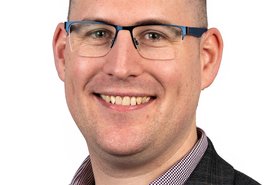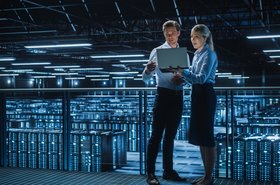In June 2024, DCD and Schneider Electric hosted an Innovation Day, themed “Developing a robust Edge strategy to support future technologies,” bringing together industry experts to discuss modern Edge operations. Throughout the day, they shared insights on the evolving demand landscape, power supply issues, and management challenges in distributed computing, providing a comprehensive guide to creating a holistic roadmap for Edge operations.
Develop a blueprint for your distributed computing strategy
During the day’s first session, experts Tor Björn Minde (RISE), Adam Compton (Schneider Electric), and David Hall (AtlasEdge) examined the benefits of distributed computing, such as resiliency, data control, and carbon reduction. They tackled the topics of latency, connectivity, and standardization, emphasizing efficiency and sustainability. The panel highlighted the importance of sustainable data centers and cloud ecosystems for business growth and advocated AI for energy optimization and reduced carbon emissions.
Distributed computing in the eyes of the experts
To introduce us to the topic, each panelist offered their take on distributed and Edge computing.
Minde explained that distributed computing covers a wide range from device-level Edge computing to the “Internet Edge” with streaming applications, requiring solutions tailored to specific use cases and locations.
Hall added that the goal is to perform distributed computing where it makes the most sense – whether that’s on a device, in a data center, or somewhere in between – to enable low-latency, high-performance applications closer to where data is generated and consumed.
Compton concluded by emphasizing that distributed computing places resources nearer to data generation and consumption, supporting low-latency use cases like personalized learning, safety monitoring, and smart manufacturing:
“Higher education is a prime example. With children in college myself, I’ve witnessed firsthand the shift to a mixed-learning environment. Personalized learning is key – a student’s path can now vary widely in a class of 25, adapting dynamically as they progress. It’s no longer just lectures and tests; education has become highly dynamic.”
Edge computing and its impact
Panelists discussed Edge computing’s impact across various industries, emphasizing connectivity as a core component. Edge computing has matured, leading to numerous viable applications and driving adoption in areas like machine learning, higher education, and factory operations. Hall affirmed:
“I always think connectivity is the starting point because a data center or device without it isn’t truly ‘Edge.’ But lately, we’re focusing less on connectivity itself. It’s not that solving that isn’t important; we understand its role.
"Now, the connectivity is there. Companies building data centers, like Schneider, and their teams are creating use cases and tools. These help organizations understand how to use these capabilities effectively. That’s why it’s an exciting time; Edge isn’t just a concept on a slide anymore. It’s real, driving tangible business value, whether in healthcare, education, or beyond.”
Minde illuminated this notion with an example from the mining industry, where drones used for safety initially relied on onboard computing, draining battery life. Offloading to the cloud caused latency issues, delaying critical decisions. By moving computing closer to the mine, they minimized latency and improved safety, showcasing Edge computing’s ability to enhance operational efficiency and safety.
Sustainability and resilience
Panelists discussed Edge computing’s impact on sustainability and resilience, noting the EU’s goal of reaching 10,000 Edge nodes by 2030, underscoring governmental interest in developing the industry to meet diverse needs in hospitals and other sectors.
Hall highlighted Edge computing’s sustainability potential, such as reusing data center heat for nearby facilities and innovating in energy storage and distribution. Off the back of this, Compton explained how Schneider aims to optimize energy demand and reduce carbon emissions in data centers through AI-driven solutions:
“A recent Forbes article discusses Schneider’s approach to AI through three key points: facilitating access to clean energy sources, optimizing energy usage by deciding when to consume or store energy, and reducing overall energy consumption and associated carbon emissions. If you apply these three priorities across Schneider and the businesses we serve, you can apply them directly to data centers.”
Partnerships and standardization
Panelists emphasized educating investors and the public on data centers’ environmental impact and sustainable computing opportunities. They stressed the need for collaboration among diverse partners to balance competition and cooperation, all crucial elements for successful Edge computing strategies. Compton highlighted:
“It comes down to partnerships, blending competition and cooperation, and breaking things down into consumable pieces, like ‘on-premise’ solutions for capacity, data protection, control, or AI model training. This also involves real estate considerations, requiring partners who can provide the necessary space and access.” He added:
“Standardization, like Schneider’s recent announcement of standardized AI designs with Nvidia, is a great way to maintain control over hardware, software, and services, ensuring interoperability in distributed computing environments.”
Leveraging UPS technologies to enable resilient Edge operations
Moving onto the second session, in conversation with DCD’s Alex Dickins, Schneider Electric’s Stephen Donnelly explored how uninterruptible power supply (UPS) technologies can enable resilient Edge operations in a rapidly evolving IT landscape.
Donnelly recounted how the pandemic has dramatically transformed the IT environment, noting shifts like distributed workforces, increased cloud adoption, and the proliferation of Edge computing. He emphasized how this has placed new demands on IT managers, who must now prioritize resiliency, security, and sustainability across a more dispersed infrastructure.
Optimizing data centers and UPS for resiliency, security, and sustainability
Donnelly expressed the criticality of resiliency, as two-thirds of power outages in the US cost businesses at least $100,000. In turn, Schneider’s UPS products are becoming more power-dense, scalable, and remotely manageable to support this need, with advanced battery technologies and connectivity features allowing IT teams to monitor and maintain UPS systems without physical access. Donnelly reiterates this as a key capability as Edge sites multiply.
In the same vein, physical and cyber security are paramount as the number of network-connected devices grows. Donnelly emphasized the importance of firmware updates and physical security measures like password-protected screens and lockable enclosures.
He noted that “physical security is cybersecurity” – the two are inextricably linked in protecting against disruption.
Sustainability is the third pillar, with Donnelly noting that 99 percent of customers now consider it a priority. Schneider’s product design focuses on improving energy efficiency, using more environmentally friendly materials, and enabling end-of-life recycling programs. One example he provides is the 50 percent reduction in plastic usage by adopting aluminum components.
These efforts align with growing corporate mandates around scope three emissions and data center sustainability.
Using lithium-ion UPS technology for efficient and sustainable edge computing
As the conversation moves on to real-world use cases demonstrating the practical application and benefits of UPS tech at Edge locations, Donnelly shared a case study of a leading medical university leveraging Schneider’s lithium-ion UPS technology to power its expanding IT infrastructure. Its power density, efficiency, and sustainability features have enabled the university to future-proof its Edge computing capabilities.
Donnelly acknowledged the challenges of managing complexity and scale with limited IT resources. He emphasized the importance of understanding evolving customer needs and future-proofing solutions to address problems that have not yet surfaced.
Modern DCIM as a force for more resilient, secure, and sustainable IT
The last Innovation Day talk of the day covered a conversation between Kat Sullivan from DCD, Kevin Brown, and Bjarke Fenger from Schneider Electric. Brown and Fender provided an overview of the evolution of data center infrastructure management (DCIM) and the key challenges facing modern IT environments.
The DCIM 3.0 vision
The speakers discussed the transition from “DCIM 1.0” in the 1990s, which focused on basic power and cooling management, to “DCIM 2.0” in the 2000s, which introduced digital twins and modeling tools to help manage the influx of rack-mounted servers in enterprise data centers.
Brown identified the current movement of the industry towards “DCIM 3.0”, driven by the rise of hybrid IT, distributed edge computing, cybersecurity concerns, and the growing focus on sustainability, noting its key challenges as:
- Resiliency: Managing thousands of distributed IT assets across remote locations, without dedicated on-site IT staff
- Cybersecurity: Ensuring firmware and software are up-to-date to mitigate vulnerabilities
- Sustainability: Reporting on energy consumption and carbon footprint, both in data centers and at the edge
Brown summarized one of the most pressing updates:
“Through DCIM 1.0 and 2.0 phases, security wasn’t the top issue that we were trying to deal with. Now, it’s clearly one of the top issues for our customers. And there’s a role for DCIM in trying to make sure that your infrastructure is secure, is following your security policies, and that you have in the latest firmware update.”
Security and sustainability in IT expert software
Speakers noted that to address these challenges, Schneider Electric has developed tools like predictive analytics for UPS battery failures, simplified digital twin creation, and comprehensive sustainability reporting. The company has also invested heavily in security, including third-party certifications for its firmware and software. Fenger illustrated:
“We’ve made it possible to update hundreds of devices at a time just by clicking a button and getting the feedback. That’s just one place where we have invested in making it easy for our customers.”
Looking ahead, the speakers see continued evolution in DCIM, with a focus on anomaly detection, cloud-based solutions, and using AI/ML to provide more actionable recommendations versus just insights. The shift towards edge computing also poses new compliance reporting challenges that DCIM tools will need to address.
Overall, this talk highlights the growing complexity of modern IT infrastructure and the critical role that DCIM solutions play in ensuring resilience, security, and sustainability across the enterprise.
Conclusion: The future of Edge computing
The Innovation Day highlighted the need for robust Edge strategies to support future technologies. Experts emphasized sustainability, resiliency, and effective partnerships in managing distributed computing complexities. As Edge computing evolves, its role in driving business value across industries grows.
To find out more, watch the full sessions from the Edge Computing Innovation Day.
More from Schneider Electric
-

The safety imperative – the role of businesses in injury prevention
Safety is a non-negotiable
-

Sponsored Advancing data centers: Management and Operations Innovation Day 2024
Industry leaders discussed the evolving landscape of data center design, focusing on sustainability, AI workloads, and cutting-edge technologies
-

Sponsored Three ways for colocation data centers to cut carbon emissions in the AI world
Exploring what sustainable decision-making for data centers means with a focus on the transformative power of carbon accounting and circularity


